
Page 7
Another Trip to Queensland
It was time to fly back to Queensland again. I have been offered a drive in 169075, one of the Cents that belonged to Glen Griffen, and I wanted to call in and see Brad Bakers 169109 and also the second one he has purchased for parts, 169120.
I rose at 3 am showered and had breakfast before driving down to Tullamarine Airport for the flight to Queensland, that was due to leave at 6 am. This meant I had to be there by 5am as being 6' 4" tall I like to get in early and maybe obtain a seat with some sort of legroom. Something that I manage to do on most occasions. So it's an early start, and I had a good flight, seat one by the door and no one on the other two seats, and first off the plane. This was my best effort yet.
Arrived at 8 am and was met by my faithful driver Rusty Dyson and his lovely partner Cass, who also was flying back from Sydney and arrived about fifteen minutes after me. A quick cup of coffee and we were off, driving down to Glen Griffin's driving area, about 1 hours drive down towards the Gold Coast.
We were met by Glen and 169075 was started up, and driven through the scrub to a nice open paddock with a small hill and a slope to the left. Brad Baker also arrived for a look and we then proceeded to plough up the paddock. Both Rusty and myself had a couple of drives and enjoyed ourselves immensely, being able to obtain fifth gear and having enough room to really try her out

Cass appeared to be enjoying herself and showed a genuine interest in the old cent, something that rather surprised me but at the same time I thought it rather nice that we also had a Tankie Lady in our group.

Just a little adjustment and we will be ready to go
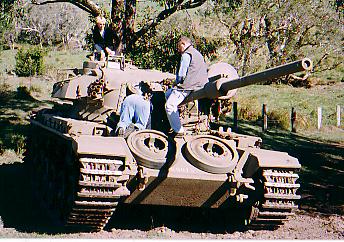
The seat needs to be moved back a bit

There is plenty of room out the front, for a good drive

Rusty starts to move off

and he soon has speed up with a nice stick change

Coming back I tried for a good front on shot

and this is where I decided to move out of the road, as Rusty was in fifth going hard
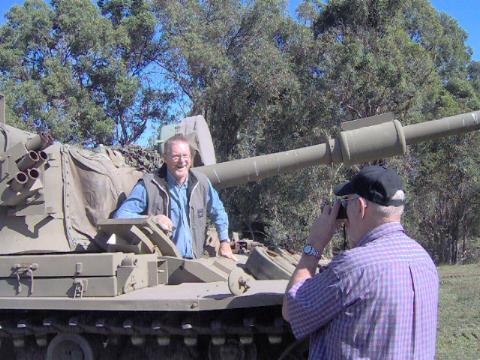
After a good fast drive Rusty was only to happy to pose for a shot

It was now my turn

Giving her a bit of stick and she was moving lovely

It was great to hit fifth

075 really had speedup here
 .
.
It was a great feeling to be able to go up and down the gears, without worry of running out of room
She steered nice and had plenty of power, and the box was sweet, no troubles with the gear changes
Glen's business commitments took him away and so we then spent some time looking at Brads 169120 and all the other items on the property, most of which Glen wishes to sell.
Anyone interested just contact me through the Guest Book on the index page of Steel Thunder

169120 - Hopefully this tank will end up at Tongala Vietnam Veterans memorial
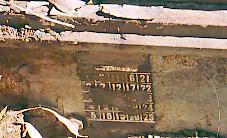
This id plate in the engine compartment is often overlooked and does contain the serial number of the tank, something that is not widely known!

The hour meter has also been removed, these were fitted after 1971 I think

The Gearbox and Aux Gen have been removed, She came with a full set of scopes as well

Front view of a Saracen Armoured personal carrier

Rear view of the APC

Nice little Stuart

Rear engine compartment of the Stuart

Studebaker 6 x 6 and a 1942 Toyota light truck carrier

White Scout Car

Short 25 Pounder

Staghound Armoured Car Shell
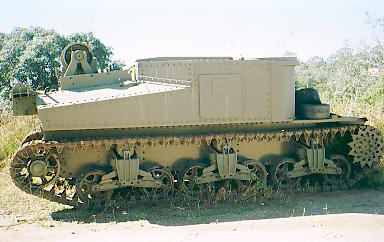
Grant ARV
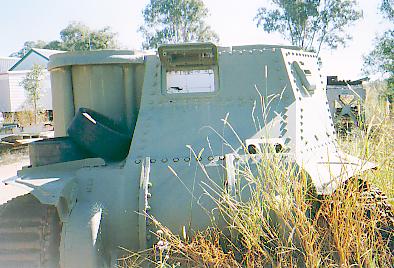
Front view of the Grant

Rear View of the Grant
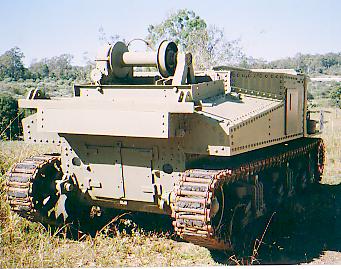
I was told that this is the only Grant ARV in Australia, which would make it rather rare.
I managed to blow away two full rolls of film plus some video footage, and we did in fact have a great time, and it was all to soon that we had to leave.
In the afternoon we returned to Cass and Rusty property for a very nice shower, dinner and great company. It was at this time that the bottle of Port was produced and enjoyed, and was without doubt the best Port I have ever sampled. Very tired we headed off to bed and after a great sleep we rose about 7 am. After a very nice breakfast, we headed off toward Brisbane and then to Nambour. This was about two and a half hours drive and Rusty managed this without becoming lost, a feat that surprised me, but then its hard to become lost on a freeway.
We arrived at Alan Hills property. Alan, who unfortunately was away on a holiday, but Brad Baker was there with 169109. She was still running like a very sick dog and had no power at all and was putting out a lot of smoke.

The smoke was one thing, but she also had pretty bad muffler leaks which I myself thought could cause the miss in the motor, but it's more likely plugs

She was sure blowing some smoke
Brad later changes some plugs and cut the smoke to the right bank, hopefully more changes to the left bank will help considerably.

There was some worry about an oil leak but when we later fixed the magneto , this solved the oil leak as well.
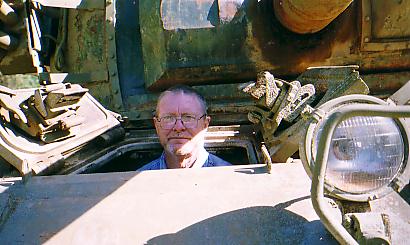
Rusty trying to get her moving
Both Rusty and I tried but really could do no better than first as she did not want to move far in second without stalling. We were really in a bit of a quandary, as she still was the fastest Tank I had ever seen when it come to starting and she idled fairly well with just a few misses. I was of the opinion that if we had the room and could give her a good run in fifth for awhile, maybe a few bugs would be ironed out, and the plugs blown clean. But we were not able to do this as the driving area was quite restricted. But all of us felt that there was something strange about the whole thing.

There was quite a bit of discussion on the matter
It was about this time that I remembered a day on the Pucka range. My tank suddenly lost power and I really had a massive loss of power. I could not take off in second and had to use first.
At this point of time I will explain the use of first gear for the people that were not drivers. First had a gate across the slot which restricted entry into first gear. The gear was mainly used for very hard climbs, which were quite rare, and also in boggy ground. Other than that you always used second to start off. If first was required it was mostly selected from a stationary position. But there was the very rare occasion, that you would come across a sudden boggy section, and this was where you did not want to stop the tank at any price. So it was necessary to change down from second to first on the move. This was in fact a bit of an art form, you had to wait till the motor was on the point of stalling and then do a double clutch change to first using both hands to force the gearstick past the gate, too early or too late and you were history. Climbing a hill meant you did an angels run backwards down the hill, and as there was no way the brakes would stop you, you just hoped there were no trees. You could not see and the experience would be terrifying. If you were in boggy ground it meant you most likely would sink. So every driver had to know how to do a "Stall Change", and we were all trained to do this. But in actual fact it was very rarely used. Now back to my story.
I was able to start off in First gear and had to floor the accelerator, which meant I was on the governors which caused the motor to backfire very loudly and was something you just were not allowed to do. A quick change to second and she rapidly lost power and it was then a stall change back to first and then repeat the whole performance again, and again and again, until I arrived back at the leaguer. The noise was pretty horrific and I expected to be in a lot of trouble, but my Crew Commander Cpl. Dick Thompson took full responsibility.
I explained this to both Rusty and Brad, and said this trouble with 169109 felt the same! And my trouble on the Pucka Range was caused by a faulty magneto on the left bank. We knew the trouble in this case was also on the left bank of the big V12. We decided to check and ran a magneto test on both banks and the left hand one was without doubt crook. A closer inspection showed the magneto was in fact very loose and close to falling out. This also showed an oil leak from the block The magneto was tightened and both the oil leak and the trouble were rectified. Rusty took her for a quick spin and she flew.

Rusty with a big smile now!
From a tank that we could not get to operate from second, she now shot away and Rusty achieved second, third and fourth gear in about 60 yards, only stopping as he was about to enter a very large deep dam. But we now knew that that particular trouble had been eliminated!
At this point of time I would like to mention the "Stick Change." I myself never heard of a Stick Change when I served in the early 1950's but it must have appeared somewhere before Vietnam as I believe it was taught to the drivers over there. It appears to be quite simple. Once moving you no longer use the clutch, removing the use of the double clutch which did in fact make a days driving quite tiring. As you went to change up you just flicked the steering stick and this put a brake on the gearbox and you then slipped it into the next gear, no clutch and a very quick change. Rusty does this all the time without any effort, in fact he was surprised when I asked him about them and said he had been using them automatically. Myself I have never done one and do not feel I should try and learn at my age with someone else's tank, but there is no doubt that Rusty is a far better and faster driver than I am so they must do the job!

We were having a look at some items that came with 169120, ,the spare tank Brad brought as well

This background shot shows the jungle like growth, lets face it, it is jungle!
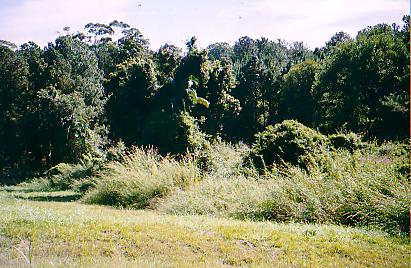
The whole perimeter is like this and then you can add a steep slope

It was our hope that we could cut a track with the Cent so as that we could travel around the perimeter

There was a very old track that had been overgrown over the years, that we hoped to use.
In the main it was a job that I felt we could do, even removing the large trees would not stop the Cent. The fact that on one side we had to skirt a creek, was just a matter of care. But as we climbed further up there appeared a few very large rocks in the track, much to large to remove, and the worry that the tank could end up on one with maybe the tracks off the ground meant that it could then stay there for life! Recovery there would be very very expensive if it could be done at all. So it looks like this home will be a place of repair only, something that in the original idea was all we were looking for anyway. A driving area would have just been a bonus.
THE RPG2 and RPG7
The armour crews in Vietnam had a lot to put up with but without doubt the RPG's and mines would I feel be the biggest worry.
The RPG2 that was used at the early part of the campaign was a weapon that could penetrate the hull of a Centurion.

The RPG2

RPG2 Round
The
action of the round which was called a PG2 Anti-Tank Round was a bit like the
APCBC that when fired it hit the target and like cow dung stuck to the target
and then a chemical action took place that heated the area and the tungsten core
of the round inverted and burnt through the armour coming out on the inside of
the tank about the size of a little babies finger and at a great velocity and
bounced about.
The round required set back to arm the round and it also had the ability to self-destruct after 600/800metres should it hit nothing.
One Vet driver told me of an incident where a RPG operator appeared in front of his tank. He was very close and the driver could see he was terrified, he was shaking so much that from about 30 ft away he missed the tank completely.

The RPG-7 is a shoulder-fired, muzzle-loaded, antitank and antipersonnel grenade launcher which launches a variety of fin-stabilized, oversized grenades from a 40mm tube. The launcher with optical sight weighs 6.9 kilograms (15.2 pounds) and has a maximum effective range of 300 meters against moving point targets and 500 meters against stationary point targets.
The maximum range for antitank grenades against area targets is 920 meters, at which point the round self-destructs after its 4.5 second flight. The antipersonnel grenades reach over 1100 meters. Among the production grenades are the PG-7, PG-7M, PG-7N, and PG-7VL antitank grenades with armour penetrability of up to 600mm of rolled homogeneous steel. The PG-7VR is a tandem warhead designed to penetrate explosive reactive armour and the armour underneath. The OG-7 and OG-7M are high-explosive antipersonnel grenades.